Three-Dimensional Double-Layer Multi-Stage Thermal Management Fabric for Solar Desalination
Abstract
1. Introduction
2. Experimental Section
2.1. Experimental Materials
2.2. Observation of Sample Morphology
2.3. Wetting Performance Test
2.4. Characterization of Surface Functional Groups
2.5. Evaporation Performance Test
2.6. Desalination and Outdoor Performance Test
2.7. Preparation of DLE
2.7.1. Preparation of GO Slurry
2.7.2. Preparation of GO Composite Yarn
2.7.3. Preparation of Double-Layer Photothermal Fabric
3. Results and Discussion
3.1. Characterization of Samples
3.2. Thermal Management and Evaporation
3.3. Wind Energy and Evaporation
3.4. The Stability Performance of DLE
3.5. Desalination Capacity of the DLE System
3.6. Outdoor Desalination Test
4. Conclusions
Author Contributions
Funding
Data Availability Statement
Conflicts of Interest
References
- Zhang, L.; Xu, Z.; Zhao, L.; Bhatia, B.; Zhong, Y.; Gong, S.; Wang, E.N. Passive, high-efficiency thermally-localized solar desalination. Energy Environ. Sci. 2021, 14, 1771–1793. [Google Scholar] [CrossRef]
- Zhang, X.P.; Qu, H.; Li, X.Y.; Zhang, L.A.; Zhang, Y.X.; Yang, J.C.; Zhou, M.J.; Suresh, L.; Liu, S.Q.; Tan, S.C. Autonomous Atmospheric Water Harvesting over a Wide RH Range Enabled by Super Hygroscopic Composite Aerogels. Adv. Mater. 2024, e2310219. [Google Scholar] [CrossRef] [PubMed]
- Bai, Z.; Xu, H.; Yang, B.; Yao, J.; Li, G.; Guo, K.; Wang, N.; Liang, N. Fe3O4/Diatomite-Decorated Cotton Evaporator for Continuous Solar Steam Generation and Water Treatment. Materials 2022, 15, 6110. [Google Scholar] [CrossRef] [PubMed]
- Wu, X.; Lu, Y.; Ren, X.; Wu, P.; Chu, D.; Yang, X.; Xu, H. Interfacial Solar Evaporation: From Fundamental Research to Applications. Adv. Mater. 2024, 36, 2313090. [Google Scholar] [CrossRef] [PubMed]
- Ge, C.; Xu, D.; Du, H.; Zhang, X.; Song, Z.; Zhao, H.; Chen, Z.; Song, B.; Shen, Z.; Gao, C.; et al. All-In-One Evaporators for Efficient Solar-Driven Simultaneous Collection of Water and Electricity. Small Methods 2023, 7, 2300227. [Google Scholar] [CrossRef]
- Wan, P.; Gu, X.; Ouyang, X.; Shi, S.; Deng, B.; Liu, J.; Chu, P.K.; Yu, X.-F. A versatile solar-powered vapor generating membrane for multi-media purification. Sep. Purif. Technol. 2021, 260, 117952. [Google Scholar] [CrossRef]
- Ou, K.; Li, J.; Hou, Y.; Qi, K.; Dai, Y.; Wang, M.; Wang, B. Hierarchical nanofibrous and recyclable membrane with unidirectional water-transport effect for efficient solar-driven interfacial evaporation. J. Colloid Interface Sci. 2024, 656, 474–484. [Google Scholar] [CrossRef] [PubMed]
- Li, R.; Zhou, C.; Yang, L.; Li, J.; Zhang, G.; Tian, J.; Wu, W. Multifunctional cotton with PANI-Ag NPs heterojunction for solar-driven water evaporation. J. Hazard. Mater. 2022, 424, 127367. [Google Scholar] [CrossRef]
- Zhou, X.; Zhao, F.; Guo, Y.; Zhang, Y.; Yu, G. A hydrogel-based antifouling solar evaporator for highly efficient water desalination. Energy Environ. Sci. 2018, 11, 1985–1992. [Google Scholar] [CrossRef]
- Yang, Z.; Wu, Y.; Han, C.; Quan, Y.; Li, Y.; Wang, W.; Min, X.; Xiong, J.; Li, M. Fe3O4-polyvinyl alcohol sponge as photo-absorber in interfacial solar steam generation. Desalination 2023, 564, 116796. [Google Scholar] [CrossRef]
- Ge, C.; Xu, D.; Du, H.; Chen, Z.; Chen, J.; Shen, Z.; Xu, W.; Zhang, Q.; Fang, J. Recent Advances in Fibrous Materials for Interfacial Solar Steam Generation. Adv. Fiber Mater. 2023, 5, 791–818. [Google Scholar] [CrossRef]
- Zhao, J.; Liu, Z.; Low, S.C.; Xu, Z.; Tan, S.H. Electrospinning Technique Meets Solar Energy: Electrospun Nanofiber-Based Evaporation Systems for Solar Steam Generation. Adv. Fiber Mater. 2023, 5, 1318–1348. [Google Scholar] [CrossRef]
- Wang, L.; Fu, X.; He, J.; Shi, X.; Chen, T.; Chen, P.; Wang, B.; Peng, H. Fiber-Based Materials: Application Challenges in Fiber and Textile Electronics (Adv. Mater. 5/2020). Adv. Mater. 2020, 32, 2070033. [Google Scholar] [CrossRef]
- Gao, C.; Zhou, B.; Li, J.; Chen, Y.; Wang, Q.; Mao, J.; Guo, J. Reversed vapor generation with Janus fabric evaporator and comprehensive thermal management for efficient interfacial solar distillation. Chem. Eng. J. 2023, 463, 142002. [Google Scholar] [CrossRef]
- Yang, Y.; Wang, D.; Liao, W.; Zeng, H.; Wu, Y.; Li, L.; Feng, W.; Xue, J.; Cao, H.; Chen, J.; et al. Arch-Bridge Photothermal Fabric with Efficient Warp-Direction Water Paths for Continuous Solar Desalination. Adv. Fiber Mater. 2024, 6, 1026–1036. [Google Scholar] [CrossRef]
- Hong, S.; Shi, Y.; Li, R.; Zhang, C.; Jin, Y.; Wang, P. Nature-Inspired, 3D Origami Solar Steam Generator toward Near Full Utilization of Solar Energy. ACS Appl. Mater. Interfaces 2018, 10, 28517–28524. [Google Scholar] [CrossRef]
- Ivan, M.N.A.S.; Saha, S.; Saleque, A.M.; Ahmed, S.; Thakur, A.K.; Bai, G.; Miao, Z.; Saidur, R.; Tsang, Y.H. Progress in interfacial solar steam generation using low-dimensional and biomass-derived materials. Nano Energy 2024, 120, 109176. [Google Scholar] [CrossRef]
- Yu, S.; Gu, Y.; Chao, X.; Huang, G.; Shou, D. Recent advances in interfacial solar vapor generation: Clean water production and beyond. J. Mater. Chem. A 2023, 11, 5978–6015. [Google Scholar] [CrossRef]
- Wang, J.; Cao, X.; Cui, X.; Wang, H.; Zhang, H.; Wang, K.; Li, X.; Li, Z.; Zhou, Y. Recent Advances of Green Electricity Generation: Potential in Solar Interfacial Evaporation System. Adv. Mater. 2024, 36, 2311151. [Google Scholar] [CrossRef]
- Zang, L.; Sun, L.; Zhang, S.; Finnerty, C.; Kim, A.; Ma, J.; Mi, B. Nanofibrous hydrogel-reduced graphene oxide membranes for effective solar-driven interfacial evaporation and desalination. Chem. Eng. J. 2021, 422, 129998. [Google Scholar] [CrossRef]
- Yang, F.; Chen, J.; Ye, Z.; Ding, D.; Myung, N.V.; Yin, Y. Ni-based Plasmonic/Magnetic Nanostructures as Efficient Light Absorbers for Steam Generation. Adv. Funct. Mater. 2021, 31, 2006294. [Google Scholar] [CrossRef]
- Gao, T.; Wang, Y.; Wu, X.; Wu, P.; Yang, X.; Li, Q.; Zhang, Z.; Zhang, D.; Owens, G.; Xu, H. More from less: Improving solar steam generation by selectively removing a portion of evaporation surface. Sci. Bull. 2022, 67, 1572–1580. [Google Scholar] [CrossRef] [PubMed]
- Du, H.; Ge, C.; Xu, D.; Qian, Y.; Chen, Z.; Gao, C.; Song, B.; Shen, Z.; Chen, J.; Liu, K.; et al. Multifunctional woven fabric for integrated solar-driven water generation and personal thermal management. Cellulose 2023, 30, 9207–9220. [Google Scholar] [CrossRef]
- Liu, Y.; Yang, N.; Gao, C.; Li, X.; Guo, Z.; Hou, Y.; Zheng, Y. Bioinspired Nanofibril-Humped Fibers with Strong Capillary Channels for Fog Capture. ACS Appl. Mater. Interfaces 2020, 12, 28876–28884. [Google Scholar] [CrossRef] [PubMed]
- Ma, C.; Liu, Q.; Peng, Q.; Yang, G.; Jiang, M.; Zong, L.; Zhang, J. Biomimetic Hybridization of Janus-like Graphene Oxide into Hierarchical Porous Hydrogels for Improved Mechanical Properties and Efficient Solar Desalination Devices. ACS Nano 2021, 15, 19877–19887. [Google Scholar] [CrossRef]
- Kang, C.K.; Kim, S.S.; Kim, S.; Lee, J.; Lee, J.-H.; Roh, C.; Lee, J. Antibacterial cotton fibers treated with silver nanoparticles and quaternary ammonium salts. Carbohydr. Polym. 2016, 151, 1012–1018. [Google Scholar] [CrossRef]
- Jankovský, O.; Lojka, M.; Jiříčková, A.; Aneziris, C.G.; Storti, E.; Sedmidubský, D. Carbon-Bonded Alumina Filters Coated by Graphene Oxide for Water Treatment. Materials 2020, 13, 2006. [Google Scholar] [CrossRef]
- Liu, X.; Zhang, K.; Wang, J. Reduced graphene oxide incorporated triple network hydrogels for enhancing solar desalination performance. Chem. Eng. J. 2024, 484, 149490. [Google Scholar] [CrossRef]
- Guo, A.; Ming, X.; Fu, Y.; Wang, G.; Wang, X. Fiber-Based, Double-Sided, Reduced Graphene Oxide Films for Efficient Solar Vapor Generation. ACS Appl. Mater. Interfaces 2017, 9, 29958–29964. [Google Scholar] [CrossRef]
- Brutin, D.; Starov, V. Recent advances in droplet wetting and evaporation. Chem. Soc. Rev. 2018, 47, 558–585. [Google Scholar] [CrossRef]
- Ge, C.; Xu, D.; Song, Y.; Liu, Y.; Feng, X.; Gao, C.; Chen, Z.; Liu, K.; Sun, Z.; Fang, J. Fibrous Solar Evaporator with Tunable Water Flow for Efficient, Self-Operating, and Sustainable Hydroelectricity Generation. Adv. Funct. Mater. 2024, 2403608. [Google Scholar] [CrossRef]
- Liang, H.; Mu, Y.; Yin, M.; He, P.-P.; Guo, W. Solar-powered simultaneous highly efficient seawater desalination and highly specific target extraction with smart DNA hydrogels. Sci. Adv. 2023, 9, eadj1677. [Google Scholar] [CrossRef] [PubMed]
- Chen, X.; Yang, M.; Zheng, S.; Temprano-Coleto, F.; Dong, Q.; Cheng, G.; Yao, N.; Stone, H.A.; Hu, L.; Ren, Z.J. Spatially separated crystallization for selective lithium extraction from saline water. Nat. Water 2023, 1, 808–817. [Google Scholar] [CrossRef]
- Guan, W.; Guo, Y.; Yu, G. Carbon Materials for Solar Water Evaporation and Desalination. Small 2021, 17, 2007176. [Google Scholar] [CrossRef]
- Xiao, X.; Pan, L.; Chen, T.; Wang, M.; Ren, L.; Chen, B.; Wang, Y.; Zhang, Q.; Xu, W. Scalable Core–Sheath Yarn for Boosting Solar Interfacial Desalination Through Engineering Controllable Water Supply. Engineering 2023, 30, 153–160. [Google Scholar] [CrossRef]
- Mao, Z.; Yao, Y.; Shen, J.; Liu, J.; Chen, Y.; Zhou, B.; Chen, Y.; Wang, Q.; Lu, J. Passive interfacial cooling-induced sustainable electricity–water cogeneration. Nat. Water 2024, 2, 93–100. [Google Scholar] [CrossRef]
- Chen, M.; Li, S.; Chen, X.; Huang, Y.; Liu, B.; Yan, H.; Sheldon, B.W.; Li, Q.; Shi, C. 3D bridge-arch-structured dual-side evaporator for practical, all-weather water harvesting and desalination. J. Mater. Chem. A 2024, 12, 9574–9583. [Google Scholar] [CrossRef]
- Xu, D.; Ge, C.; Chen, Z.; Liu, Y.; Du, H.; Gong, H.; Gao, C.; Shen, Z.; Xu, W.; Liu, K. Composite Braided Fabric Coupled with Photothermal and Electrothermal Processes for Stable and Continuous All-Day Desalination. ACS Appl. Mater. Interfaces 2022, 14, 52087–52095. [Google Scholar] [CrossRef] [PubMed]
- Lan, Q.; Feng, C.; Wang, Z.; Li, L.; Wang, Y.; Liu, T. Chemically Laminating Graphene Oxide Nanosheets with Phenolic Nanomeshes for Robust Membranes with Fast Desalination. Nano Lett. 2021, 21, 8236–8243. [Google Scholar] [CrossRef]
- Sheng, M.; Yang, Y.; Bin, X.; Zhao, S.; Pan, C.; Nawaz, F.; Que, W. Recent advanced self-propelling salt-blocking technologies for passive solar-driven interfacial evaporation desalination systems. Nano Energy 2021, 89, 106468. [Google Scholar] [CrossRef]
- Dao, V.-D.; Vu, N.H.; Yun, S. Recent advances and challenges for solar-driven water evaporation system toward applications. Nano Energy 2020, 68, 104324. [Google Scholar] [CrossRef]
- Lu, X.; Mu, C.; Liu, Y.; Wu, L.; Tong, Z.; Huang, K. Recent advances in solar-driven interfacial evaporation coupling systems: Energy conversion, water purification, and seawater resource extraction. Nano Energy 2024, 120, 109180. [Google Scholar] [CrossRef]
- Li, W.; Zheng, Z.; Qian, Z.; Liu, H.; Wang, X. Phase Change Material Boosting Electricity Output and Freshwater Production through Hierarchical-Structured 3D Solar Evaporator. Adv. Funct. Mater. 2024, 34, 2316504. [Google Scholar] [CrossRef]
- Wang, Y.; Wu, X.; Gao, T.; Lu, Y.; Yang, X.; Chen, G.Y.; Owens, G.; Xu, H. Same materials, bigger output: A reversibly transformable 2D–3D photothermal evaporator for highly efficient solar steam generation. Nano Energy 2021, 79, 105477. [Google Scholar] [CrossRef]
- Sheng, N.; Peng, Y.; Sun, F.; Hu, J. High-Performance Fasciated Yarn Artificial Muscles Prepared by Hierarchical Structuring and Sheath–Core Coupling for Versatile Textile Actuators. Adv. Fiber Mater. 2023, 5, 1534–1547. [Google Scholar] [CrossRef]
- Chen, T.; Wang, Y.; Wang, M.; Ren, L.; Xiao, X.; Zhang, Q.; Xu, W. Continuous solar-driven saturated brine separation using sawtooth photothermal fabrics with asymmetrical wetting property. Chem. Eng. J. 2024, 481, 147579. [Google Scholar] [CrossRef]
- Park, Y.; Park, M.-J.; Lee, J.-S. Reduced Graphene Oxide-Based Artificial Synapse Yarns for Wearable Textile Device Applications. Adv. Funct. Mater. 2018, 28, 1804123. [Google Scholar] [CrossRef]
- Chao, W.; Sun, X.; Li, Y.; Cao, G.; Wang, R.; Wang, C.; Ho, S.-H. Enhanced Directional Seawater Desalination Using a Structure-Guided Wood Aerogel. ACS Appl. Mater. Interfaces 2020, 12, 22387–22397. [Google Scholar] [CrossRef]
- Ge, C.; Xu, D.; Feng, X.; Du, H.; Chen, Z.; Ong, H.L.; Gao, C.; Yan, G.; Fang, J. 3D spacer fabric structured airflow channel for enhanced solar desalination with efficient multi-energy harvesting. Sep. Purif. Technol. 2025, 354, 128849. [Google Scholar] [CrossRef]
- Younes, Y.A.; Kospa, D.A.; Salama, R.S.; Ahmed, A.I.; Ibrahim, A.A. Hydrophilic candle wastes microcapsules as a thermal energy storage material for all-day steam and electricity cogeneration. Desalination 2023, 550, 116377. [Google Scholar] [CrossRef]
- Dang, C.; Wang, H.; Cao, Y.; Shen, J.; Zhang, J.; Lv, L.; Xu, G.; Zhu, M. Ultra salt-resistant solar desalination system via large-scale easy assembly of microstructural units. Energy Environ. Sci. 2022, 15, 5405–5414. [Google Scholar] [CrossRef]


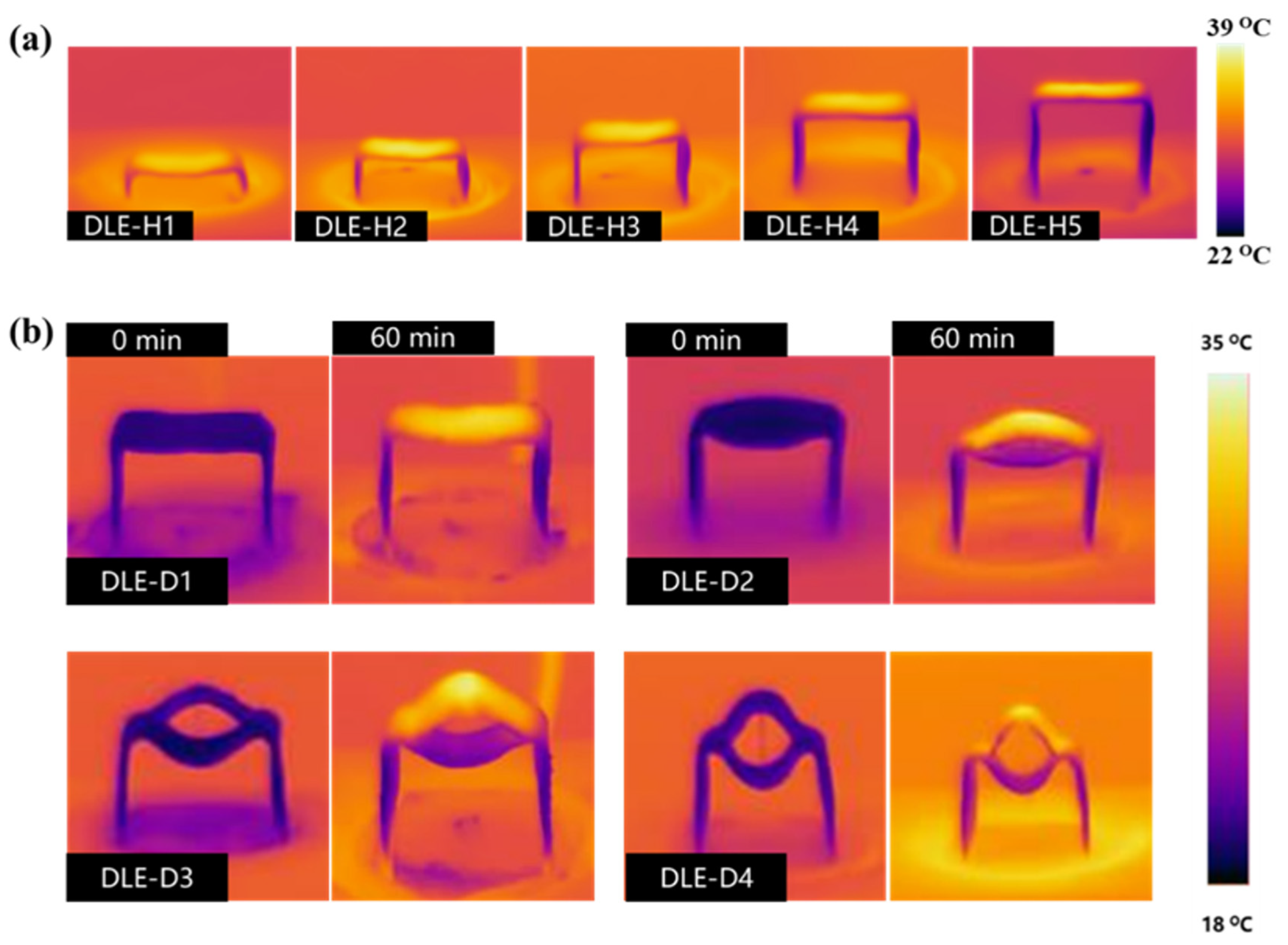
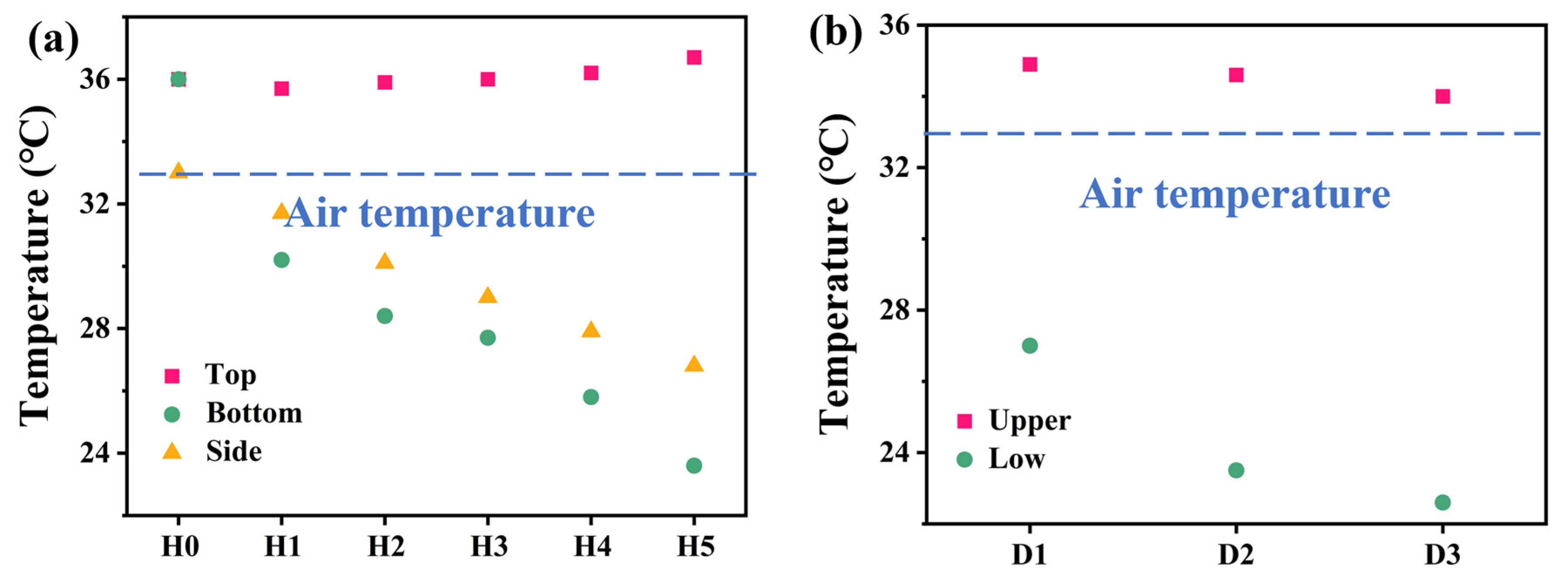
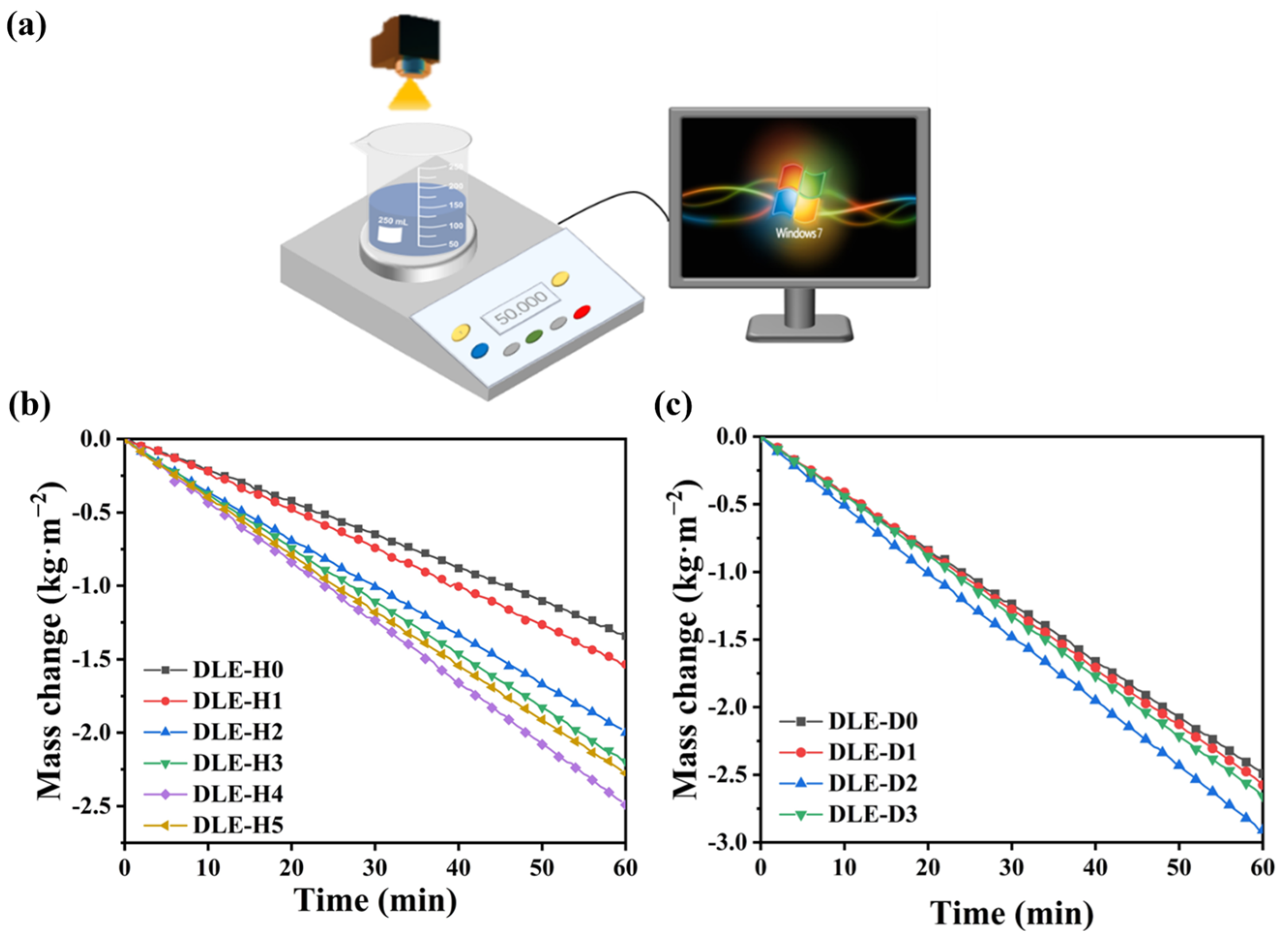
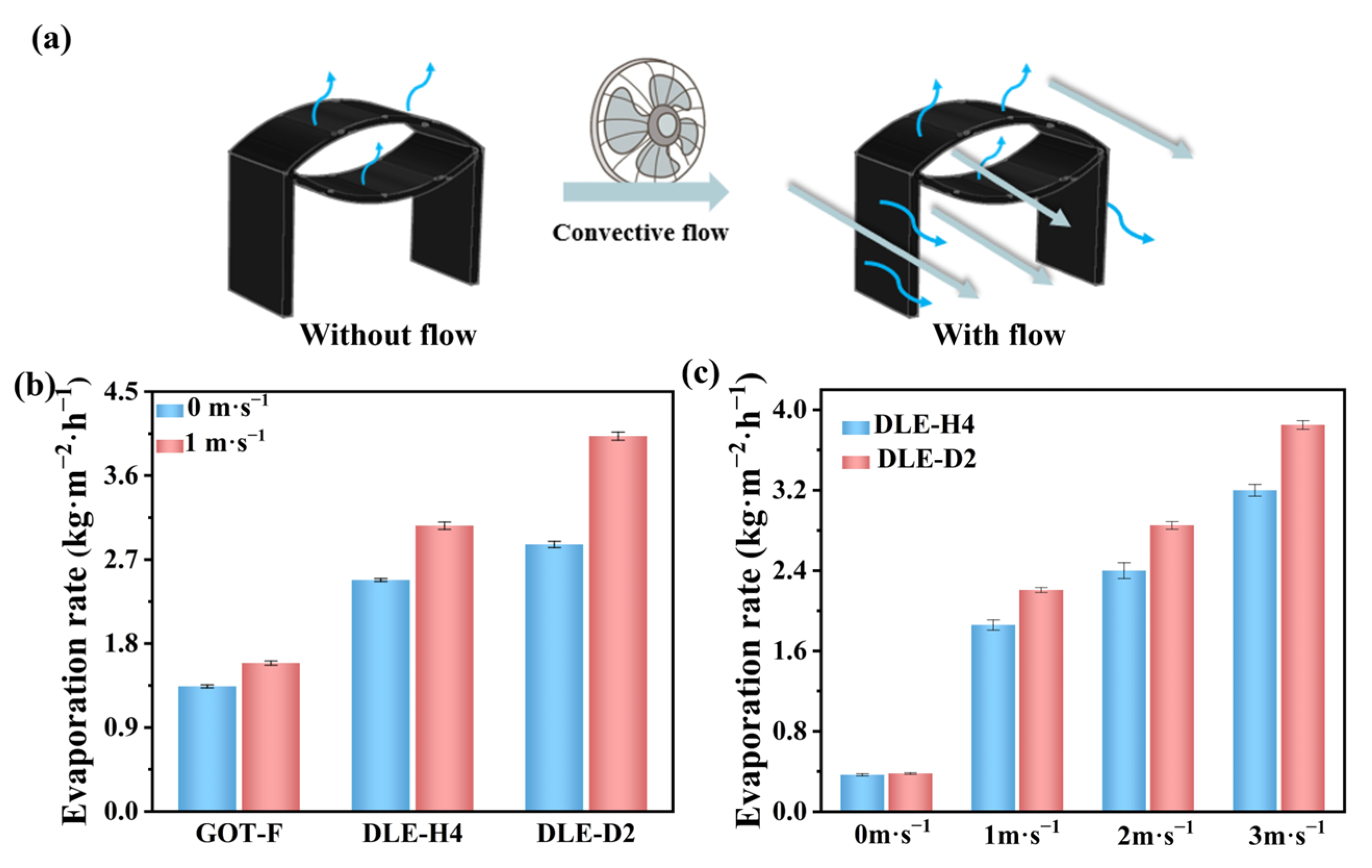
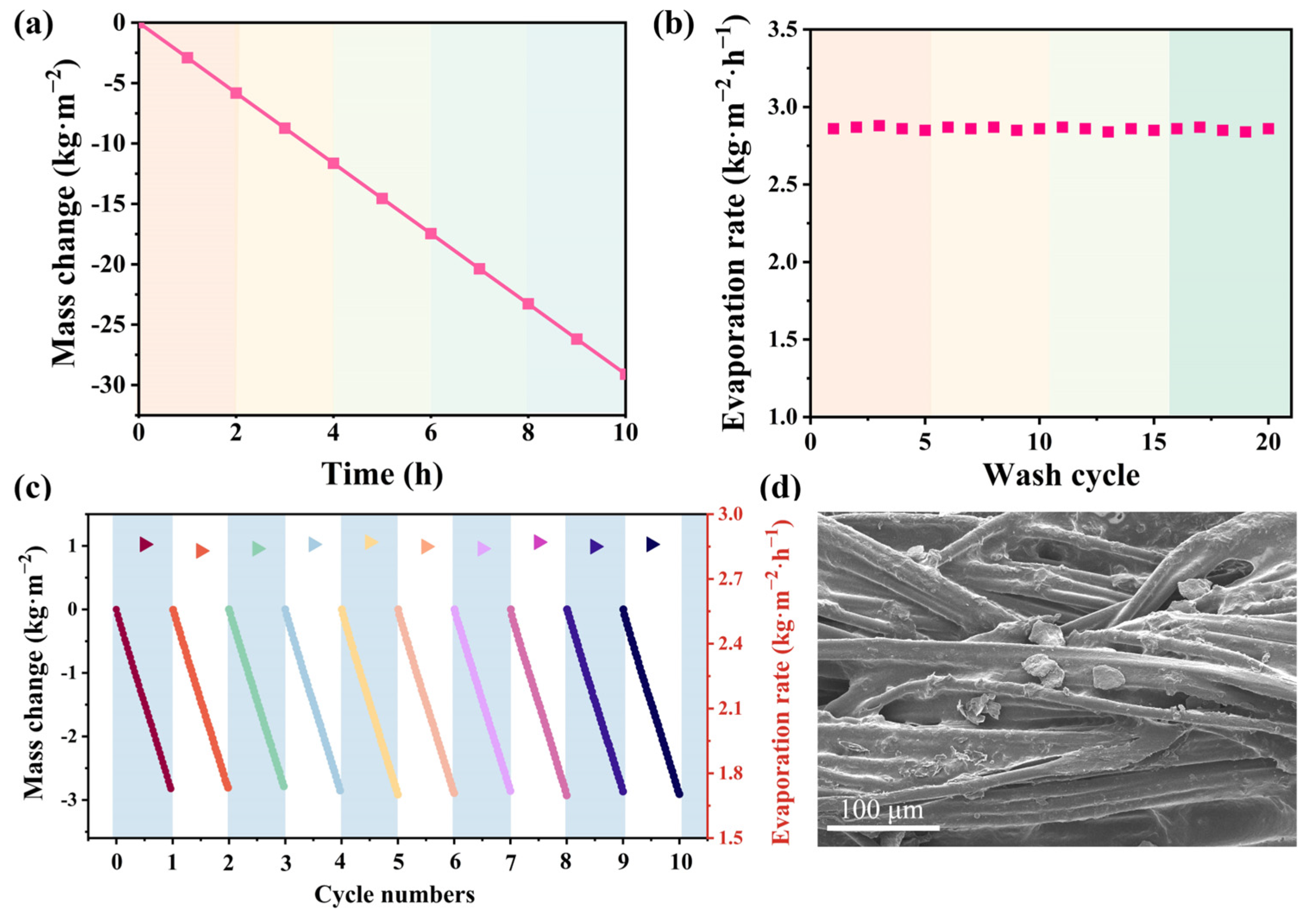
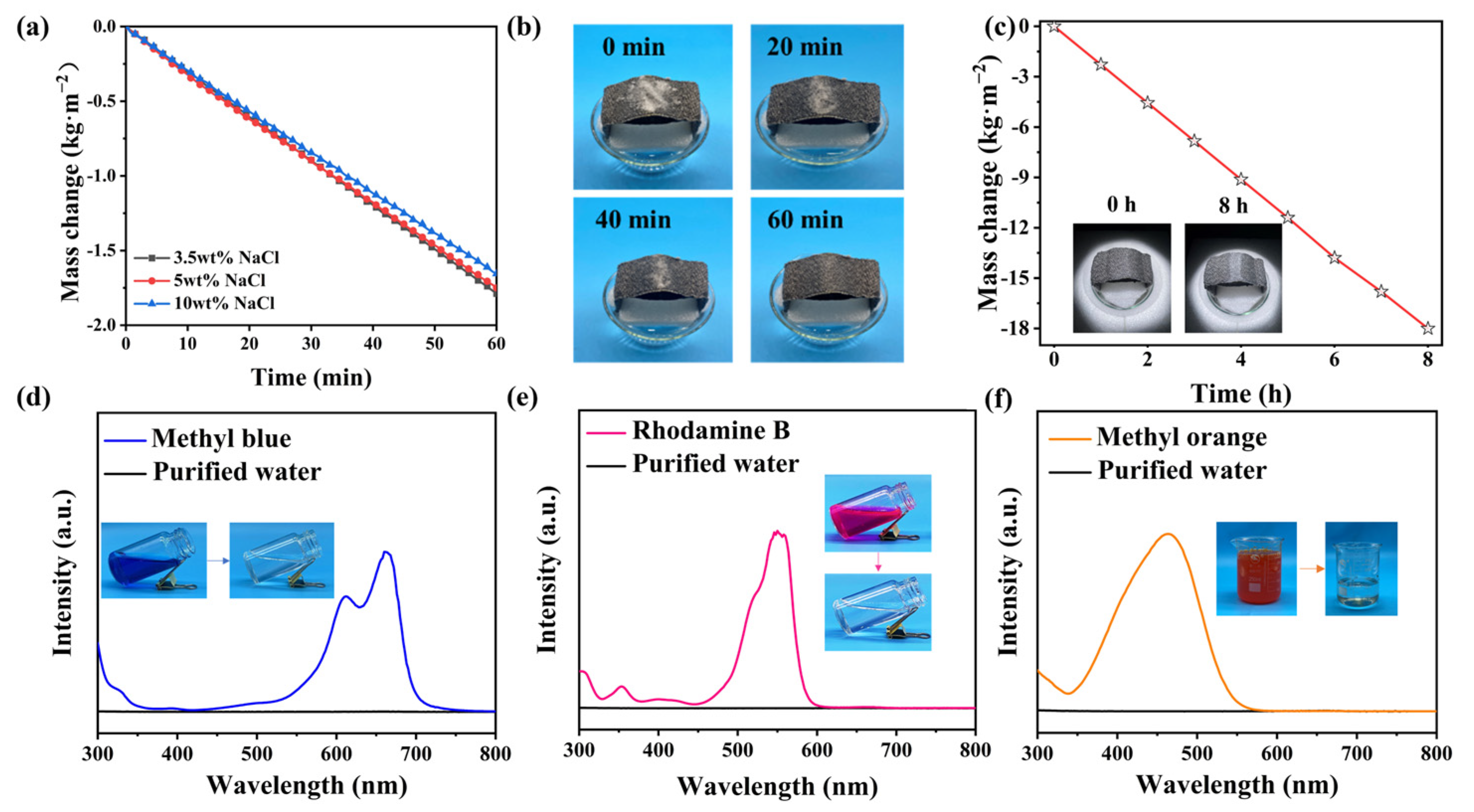

Disclaimer/Publisher’s Note: The statements, opinions and data contained in all publications are solely those of the individual author(s) and contributor(s) and not of MDPI and/or the editor(s). MDPI and/or the editor(s) disclaim responsibility for any injury to people or property resulting from any ideas, methods, instructions or products referred to in the content. |
© 2024 by the authors. Licensee MDPI, Basel, Switzerland. This article is an open access article distributed under the terms and conditions of the Creative Commons Attribution (CC BY) license (https://creativecommons.org/licenses/by/4.0/).
Share and Cite
Feng, X.; Ge, C.; Du, H.; Yang, X.; Fang, J. Three-Dimensional Double-Layer Multi-Stage Thermal Management Fabric for Solar Desalination. Materials 2024, 17, 4419. https://doi.org/10.3390/ma17174419
Feng X, Ge C, Du H, Yang X, Fang J. Three-Dimensional Double-Layer Multi-Stage Thermal Management Fabric for Solar Desalination. Materials. 2024; 17(17):4419. https://doi.org/10.3390/ma17174419
Chicago/Turabian StyleFeng, Xiao, Can Ge, Heng Du, Xing Yang, and Jian Fang. 2024. "Three-Dimensional Double-Layer Multi-Stage Thermal Management Fabric for Solar Desalination" Materials 17, no. 17: 4419. https://doi.org/10.3390/ma17174419
APA StyleFeng, X., Ge, C., Du, H., Yang, X., & Fang, J. (2024). Three-Dimensional Double-Layer Multi-Stage Thermal Management Fabric for Solar Desalination. Materials, 17(17), 4419. https://doi.org/10.3390/ma17174419




